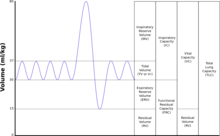Tidal volume
Tidal volume (symbol VT or TV) is the volume of air inspired and expired with each passive breath.[1] It is typically assumed that the volume of air inhaled is equal to the volume of air exhaled such as in the figure on the right. In a healthy, young human adult, tidal volume is approximately 500 ml per inspiration at rest or 7 ml/kg of body mass.[2]
Mechanical ventilation
[edit]Tidal volume plays a significant role during mechanical ventilation to ensure adequate ventilation without causing trauma to the lungs. Tidal volume is measured in milliliters and ventilation volumes are estimated based on a patient's ideal body mass. Measurement of tidal volume can be affected (usually overestimated) by leaks in the breathing circuit or the introduction of additional gas, for example during the introduction of nebulized drugs.
Ventilator-induced lung injury such as Acute lung injury (ALI) /Acute Respiratory Distress Syndrome (ARDS) can be caused by ventilation with very large tidal volumes in normal lungs, as well as ventilation with moderate or small volumes in previously injured lungs, and research shows that the incidence of ALI increases with higher tidal volume settings in nonneurologically impaired patients. .[3] Similarly A 2018 systematic review by The Cochrane Collaboration provided evidence that low tidal volume ventilation reduced post operative pneumonia and reduced the requirement for both invasive and non invasive ventilation after surgery[4]
Initial settings of mechanical ventilation:
Patients without pre-existing lung disease
[edit]Protective lung ventilation strategies should be applied with VT 6ml/kg to 8ml/kg with RR = 12 to 20 and an average starting target minute ventilation of 7 L/min.[citation needed][clarification needed]
Patients with chronic obstructive lung disease
[edit]Protective lung volumes apply 6ml/kg to 8ml/kg with a rate high enough for proper alveolar ventilation but does not create or aggravate intrinsic Positive End-Expiry Pressure (PEEP).[citation needed][clarification needed]
Acute respiratory distress syndrome
[edit]Protective lung ventilation strategies apply. VT 6 to 8 ml/kg or as low as 5 ml/kg in severe cases. Permissive hypercapnia can be employed in an attempt to minimize aggressive ventilation leading to lung injury. Higher peeps are often required however not all ARDS patients require the same peep levels.[clarification needed] Patient should be started on 6 ml/kg and PEEP increased until plateau pressure is 30 cm H20 in most severe cases.[citation needed][clarification needed]
References
[edit]- ^ Haddad, Moshe; Sharma, Sandeep (2021), "Physiology, Lung", StatPearls, Treasure Island (FL): StatPearls Publishing, PMID 31424761, retrieved 2021-03-17
- ^ Beardsell, I et al: MCEM Part A:MCQs, page 33, Royal Society of Medicine Press, 2009
- ^ Gajic, Ognjen; Saqib Dara; Jose Mendez; Abedola Adensanya; Emir Festic; Sean Caples; Rimki Rana; Jennifer StSauver; James Lymp; Bekele Afessa (2004). "Ventilator-associated lung injury in patients without acute lung injury at the onset of mechanical ventilation". Critical Care Medicine. 32 (9): 1817–1824. doi:10.1097/01.CCM.0000133019.52531.30. PMID 15343007. S2CID 6386675.
- ^ Guay, Joanne; Ochroch, Edward A; Kopp, Sandra (2018-07-09). "Intraoperative use of low volume ventilation to decrease postoperative mortality, mechanical ventilation, lengths of stay and lung injury in adults without acute lung injury". Cochrane Database of Systematic Reviews. 7 (10): CD011151. doi:10.1002/14651858.cd011151.pub3. ISSN 1465-1858. PMC 6513630. PMID 29985541.
External links
[edit]- Ricard JD (May 2003). "Are we really reducing tidal volume—and should we?". American Journal of Respiratory and Critical Care Medicine. 167 (10): 1297–8. doi:10.1164/rccm.2303003. PMID 12738592.
Text is available under the CC BY-SA 4.0 license; additional terms may apply.
Images, videos and audio are available under their respective licenses.

